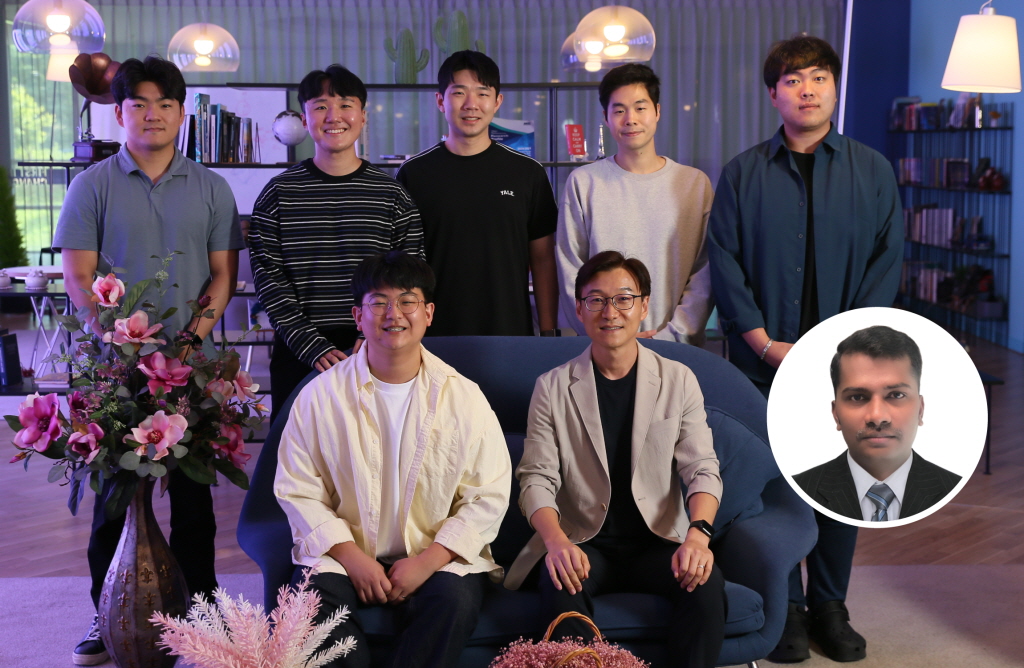UNIST(총장 이용훈) 에너지화학공학과 권영국 교수팀(제1저자 공태훈 석박통합과정 연구원)이 음이온 교환막과 지지체 사이에 촉매층을 직접 성장시켜 막전극접합체(Membrane Electrode Assembly)를 제조하는 ‘막-촉매-지지체 일체형 전극 제조기술’을 개발했다.

▲(아랫줄 왼쪽부터)제1저자 공태훈 연구원, 권영국 교수, 제1저자 탕가벨 판디아라잔 연구원 등 UNIST 연구진이 기념촬영을 하고 있다.
권영국 교수팀, 음이온교환막 활용한 새로운 촉매층 제조기술 개발
수소를 만들어내는 전해조의 성능을 크게 향상시키는 기술이 개발됐다. 그린수소 생산 기술의 상업화에 한 발 더 다가설 것으로 기대된다.
UNIST(총장 이용훈)는 에너지화학공학과 권영국 교수팀(제1저자 공태훈 석박통합과정 연구원)이 음이온 교환막과 지지체 사이에 촉매층을 직접 성장시켜 막전극접합체(Membrane Electrode Assembly)를 제조하는 ‘막-촉매-지지체 일체형 전극 제조기술’을 개발했다고 21일 밝혔다.
산소를 발생시키는 대표적인 촉매인 니켈, 철 기반의 촉매층을 음이온 교환막과 전극 지지체 사이에 직접 성장시켰다. 계면 저항을 획기적으로 개선하며 수소생산의 성능과 전극 촉매의 안정성 또한 향상시켰다.
음이온 교환막 수전해 기술은 음이온만 선택적으로 이동시키는 교환막을 전해질로 사용해 수소를 생산하는 시스템이다. 기존 시스템의 단점 보완 및 장점을 극대화한 시스템이지만 상업화를 위한 성능 및 계면 저항에 대한 개선이 필요하다.
연구팀은 먼저 강한 환원제인 BH4-를 음이온만 통과시키는 ‘음이온 교환막’을 통해 이동시켰다. 연구팀은 이렇게 이동한 환원제를 금속이온과 반응을 유도해 전극 지지체와 음이온 교환막 사이에 ‘활성 촉매층’을 성장시켰다.
이렇게 개발된 기술을 활용한 전해조는 기존 대비 두 배 낮은 계면 저항성을 보였다. 50℃ 알칼리성 환경에서 기존의 전해조보다 약 100㎷ 이상 낮은 셀 전압(1.79V)에서도 전류밀도 1A/㎠를 나타내는 우수한 성능을 보였다. 400시간 이상 구동 테스트에서는 낮은 열화 속도(0.07㎷/h)를 보이며 그 안정성을 입증했다.
연구팀은 개선된 성능과 안정성은 막전극접합체 제조 과정에서 일반적으로 사용하는 이오노머 대신 촉매층을 직접 성장시킨 것이 주요 원인임을 밝혔다.
이오노머는 기존 분말 형태의 촉매를 고정시키고 반응에 필요한 이온들을 전달하는 역할을 한다.
반면에 과량을 사용하게 되면 촉매가 반응하는 부위를 막거나 생산되는 산소 및 수소 가스 배출을 저하시켜 촉매가 탈락하는 등의 문제를 일으킨다.
개발된 기술은 이오노머를 배제하고 촉매층을 직접 성장시켜 막-촉매-지지체 계면을 최적화함으로써 성능과 안정성 모두를 개선시켰다.
권영국 에너지화학공학과 교수는 “수전해조의 성능과 안정성을 동시에 확보하는 것은 그린수소 생산 기술의 상업화에 필수적이다”며 “전해조의 핵심요소인 막전극접합체에서 야기되는 문제점을 파악하고 해결하는 원천기술을 개발하여 수소경제 실현을 앞당기겠다”고 말했다.
제 1저자인 공태훈 석박통합과정 연구원은 “기존의 막전극접합체 제조기술에서 이오노머에 의한 문제점이 뚜렷해 이오노머 없이 촉매층을 형성하는 기술개발이 필요했다”며 “음이온교환막의 특성을 활용한 화학적 환원 방법을 도입해 성능과 안정성 모두를 개선시키는 막전극접합체 제조기술을 개발했다”고 말했다.
이번 연구는 에너지·환경과학 분야의 세계적 권위지인 ‘ACS Energy Letters’에 표지 논문으로 선정돼 10월13일 온라인 게재됐고, 11월10일 출판됐다. 연구 수행은 과학기술정보통신부 한국연구재단의 중견과제, 산업통상자원부 에너지기술개발사업 등의 지원을 받아 수행됐다.
